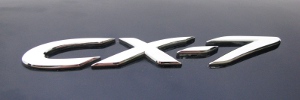















Mazda SUVs Soar In NHTSA Safety Ratings |
|---|
 Topics: Mazda CX-9
Topics: Mazda CX-9
|
Anthony Fontanelle
August 31, 2007
The Mazda Motor Corp. proves that Zoom-Zoom pride could be equally-safe as well. Earlier, the Mazda CX-9 and the CX-7 sport utilities received the highest possible ratings in frontal and side impact crashes by the National Highway Traffic Safety Administration (NHTSA).
Aside from receiving a five-star frontal and side impact crash-test rating, both the sport utilities received four-star rollover resistance ratings. No other sport utility on the market today has received ratings higher than CX-9 or the CX-7.
"This is a true testament to Mazda's advanced safety engineering that both CX-9 and CX-7 received the highest safety honors," said Jim O'Sullivan, the President and CEO of Mazda North American Operations. "While other companies can certainly build safe vehicles, we're the only company that delivers that safety with a healthy dose of Zoom-Zoom in every car and SUV."
In conducting frontal testing, the federal agency places dummies in a vehicle and crashes it into a fixed barrier at 35 mph. The instruments by the agency measure the force of impact to each dummy's head, chest and legs. In the side impact test, a 3,015 pound barrier moving at 38.5 mph is crashed into the side of the passenger compartment of the vehicle while at a stop.
The CX-9, a crossover SUV, debuted on April 13, 2006 at the New York International Auto Show. It is built on the stretched Mazda6 platform and offered as a front-wheel drive vehicle with an optional four-wheel drive system. The SUV is engineered to rival the redesigned 2008 Toyota Highlander, Nissan Murano, the all new 2007 Hyundai Veracruz, the redesigned 2009 Honda Pilot, as well as GM's Saturn Outlook, GMC Acadia and the Buick Enclave.
The crossover is the first Mazda to use Ford’s 3.5 L "Cyclone" V6 guised in the Japanese automaker’s MZI. The new engine produces 273 horsepower and 270 pound-feet of torque. Aside from the traditional Mazda clutch parts, other features include hands free Bluetooth phone link, DVD navigation system, backup camera, and rear entertainment system with Bose 5.1 surround sound.
The CX-7, meanwhile, is a crossover SUV, was introduced last year at the Los Angeles Auto Show. The crossover is built on a new platform called CD3 which it shares with siblings Mazda CX-9, Ford Edge, and Lincoln MKX crossovers.
The crossover’s power comes from the same 2.3 L straight-4 MZR engine used in the Mazdaspeed 3 and Mazdaspeed 6 coupled with a 6 speed automatic transmission, and tuned to generate 244 horsepower and 258 pound-feet of torque.
Mazda’s lineup including the Mazda3, Mazda5, Mazda6, MX-5, RX-8, CX-7, CX-9 and the Tribute are equipped with state-of-the-art safety features to help drivers prevent road accidents. Standard or optional active safety features cover Traction Control Systems (TCS), Anti-Lock Braking Systems (ABS), Dynamic Stability Control (DSC), and Tire Pressure Monitoring Systems (TMPS). These systems are standard on every CX-7, CX-9, Mazdaspeed3 and 2008 Tribute. In addition, the Tribute and the CX-9 are both equipped with standard Roll Stability Control (RSC). The said auto safety feature is the world's only system with gyroscopic sensors to actively gauge and help control yaw and roll movements.
Should an accident happen, the CX-7, CX-9 and select crossovers from the Japanese automaker also feature passive safety technologies like three-point seat belts for all seating positions, seat belt reminding systems, second row Lower Anchors and Tethers for Children (LATCH) child safety restraints, front side-impact airbags advanced dual front airbags, and air curtains. Also, CX-7, CX-9 and Tribute's side air curtains feature standard rollover protection for all rows of seating.
Source: Amazines.com
